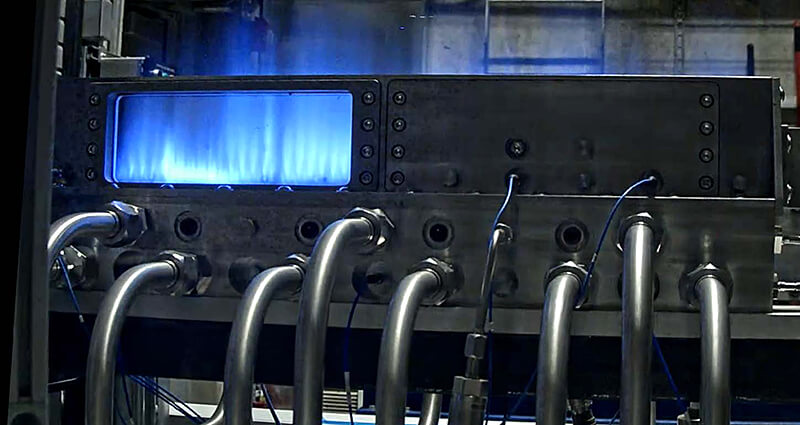November 10, 2020
Detonation-based engine offers new options for hypersonic, high-speed vehicles

Photograph of linear detonation engine in operation with methane and oxygen propellants. (Image provided)
WEST LAFAYETTE, Ind. – Researchers at Purdue University have developed new combustion technology that can shrink the size of engines and eliminates the need for them to be round in shape.
The novel combustion device has the potential for applications in many propulsion systems, including rockets and air-breathing engines for hypersonic vehicles. Engines that are linear, or rectangular in shape, will allow propulsion to be integrated into vehicles that are fully optimized for the harsh aerodynamic conditions of hypersonic flight.
Instead of burning air or other oxidizers with fuel in a steady process, as done by current rocket and jet engines, use of detonations shrinks the size of the engine and increases its efficiency.
“Continuously-operating detonation-based combustion devices can achieve a significant increase in combustor power density and yield higher engine efficiency compared to technologies used today,” said Carson Slabaugh, an assistant professor of aeronautics and astronautics in Purdue’s College of Engineering. “This next step in detonation technology that we have demonstrated allows us to break free from the prior assumption these combustors must have a connected, circular or obround combustion channel geometry. We can now consider direct integration with high-speed vehicle designs that are optimized for other factors like aerodynamics, thermal management, and flow control.”
 This GIF shows heat release from a traveling detonation wave in the combustion chamber. Propellants enter the combustor from the bottom of the image and exhaust from the top. (GIF provided)
This GIF shows heat release from a traveling detonation wave in the combustion chamber. Propellants enter the combustor from the bottom of the image and exhaust from the top. (GIF provided)
Conceptual demonstrations at Purdue have shown that a straight, linear channel can be operated continuously, without loss of performance. The combustor can also be scaled and adapted to other shapes that have varying degrees of curvature.
This aspect of the design is particular amenable to hypersonic applications, where the propulsion system is a fully integrated component of the vehicle design.
With this technology, a detonation-based propulsion system can be assimilated with any surface of a vehicle for reaction control or added thrust. Detonation-based combustion can achieve a 6-8% increase in specific impulse with a ten-fold increase in power density (heat release rate per unit volume). This novel approach offers the benefits of a rotating detonation engine with integration flexibility.
“The opportunity that this provides, especially for high-speed vehicles, is exciting,” said Rohan Gejji, a research engineer at Purdue’s Maurice J. Zucrow Laboratories. “A detonation engine design with a linear or other discontinuous geometry that retains or improves upon the benefits of rotating detonation engines, but maintains a linear geometry, can provide a significant advantage for rockets and other high-speed air-breathing vehicles.”
The Purdue researchers demonstrated the viability and operation of the technology at Zucrow Laboratories using a linear detonation combustor. Zucrow Laboratories is the largest academic propulsion lab in the world.
The team worked with the Purdue Research Foundation Office of Technology Commercialization to patent the technology. They are looking for additional partners. For more information, contact Matt Halladay from OTC at mrhalladay@prf.org and mention track code 2020-SLAB-69062.
About Purdue Research Foundation
The Purdue Research Foundation is a private, nonprofit foundation created to advance the mission of Purdue University. Established in 1930, the foundation accepts gifts; administers trusts; funds scholarships and grants; acquires property; protects Purdue's intellectual property; and promotes entrepreneurial activities on behalf of Purdue. The foundation manages the Purdue Foundry, Purdue Office of Technology Commercialization, Purdue Research Park, Purdue Technology Centers and University Development Office. In 2020, the IPWatchdog Institute ranked Purdue third nationally in startup creation and in the top 20 for patents. The foundation received the 2019 Innovation and Economic Prosperity Universities Award for Place from the Association of Public and Land-grant Universities. For more information on licensing a Purdue innovation, contact the Purdue Office of Technology Commercialization at otcip@prf.org. For more information about involvement and investment opportunities in startups based on a Purdue innovation, contact the Purdue Foundry at foundry@prf.org.
About Purdue University
Purdue University is a top public research institution developing practical solutions to today’s toughest challenges. Ranked the No. 5 Most Innovative University in the United States by U.S. News & World Report, Purdue delivers world-changing research and out-of-this-world discovery. Committed to hands-on and online, real-world learning, Purdue offers a transformative education to all. Committed to affordability and accessibility, Purdue has frozen tuition and most fees at 2012-13 levels, enabling more students than ever to graduate debt-free. See how Purdue never stops in the persistent pursuit of the next giant leap at purdue.edu.
Writer: Chris Adam, cladam@prf.org
Sources: Carson Slabaugh, cslabau@purdue.edu
Rohan Gejji, rgejji@purdue.edu

